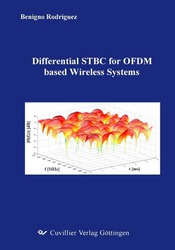| Areas | |
|---|---|
| Serie de libros (96) |
1378
|
| Nachhaltigkeit |
3
|
| Gesundheitswesen |
1
|
| Letra |
2363
|
| Ciencias Naturales |
5406
|
| Ciencias Ingeniería |
1791
|
| Ingeniería | 292 |
| Ingeniería mecánica y de proceso | 861 |
| Ingeniería eléctrica | 686 |
| Mineria y metalurgía | 30 |
| Arquitectura e ingeniería civil | 75 |
| General |
97
|
|
Leitlinien Unfallchirurgie
5. Auflage bestellen |
|
Erweiterte Suche
Differential STBC for OFDM based Wireless Systems (Tienda española)
Benigno Rodríguez Díaz (Autor)Previo
Indice, Datei (34 KB)
Lectura de prueba, Datei (69 KB)
Broadband wireless mobile data networks are an extremely important technical topic nowadays. These networks are probably the most convenient alternative for achieving the objective of providing and increasing connectivity and Internet access. For underdeveloped countries, these networks are an excellent alternative to diminish the so-called digital gap. For developed countries, they represent an opportunity to increase services, security and comfort.
Broadband wireless networks have been studied, considering their component modules, algorithms and also possibilities of interaction between them. This study was necessary to compare different technical alternatives and earn some knowledge about the related advantages and disadvantages. From this study the dominance of the Orthogonal Frequency Division Multiplexing (OFDM) transmission techniques became clear. It was also clear that multiple antenna (MIMO) systems are needed to guarantee high data rate transmission schemes. The combination between the OFDM transmission technique and multiple antenna MIMO systems is the key focus of this thesis. Robustness and bandwidth efficiency of new differential transmission techniques, improved by the use of diversities, in particular spatial diversity and the related advantages have been studied. Then the attention was focused in these areas, OFDM transmission technique in combination with a subcarrier wise processed differential and spatial diversity technique.
Differential modulation schemes have the advantage that any radio channel estimation procedure can be avoided which reduces the computation complexity dramatically. As a result of this work a new class of Differential Space Time Block Codes (DSTBCs) with high performance (lower bit error rate compared to some previously published techniques) has been proposed. The introduced technique is quite flexible and has still some potential for possible improvements (new modulation schemes, new power control mechanisms, etc.). The proposed technique was extensively tested in different radio channel conditions, like AWGN, uncorrelated Rayleigh fading and WSSUS, showing always very good performance and system robustness. When it was tested in WSSUS channels, it was found that the relative improvement (compared with the use of a pure M-PSK modulation technique or another previously published technique) is still increased when the mobile terminal velocity is increased. This suggests that the proposed technique could be particularly attractive for high mobility scenarios.
In order to increase the system performance, higher spatial diversity order has been analyzed by using receive diversity. In this case a combining technique for DSTBCs has been proposed, equivalent to Maximum Ratio Combining (MRC) for coherent systems. Observe that the conventional MRC for coherent systems cannot be directly applied to DSTBCs, since an incoherent demodulation is considered, thus there is no direct channel information available at the receiver. Consequently, this new combining technique for DSTBCs has been developed within this work.
Finally the performance of the proposed technique in a channel coded system was analyzed, showing that in this case its use is also convenient. In this study also some information about time delay and complexity, associated with the use of convolutional channel coding, was provided, in order to judge the convenience of its use for a particular application.
| ISBN-10 (Impresion) | 3867274592 |
| ISBN-13 (Impresion) | 9783867274593 |
| ISBN-13 (E-Book) | 9783736924598 |
| Idioma | Inglés |
| Numero de paginas | 182 |
| Edicion | 1 |
| Volumen | 0 |
| Lugar de publicacion | Göttingen |
| Lugar de la disertacion | Hamburg-Harburg |
| Fecha de publicacion | 18.12.2007 |
| Clasificacion simple | Tesis doctoral |
| Area |
Ingeniería eléctrica
|








